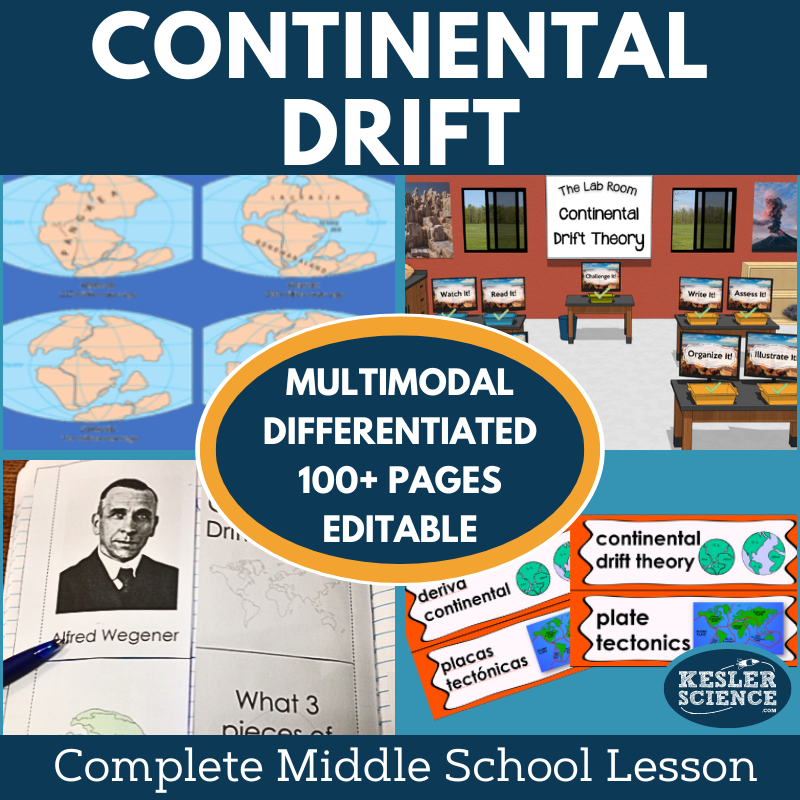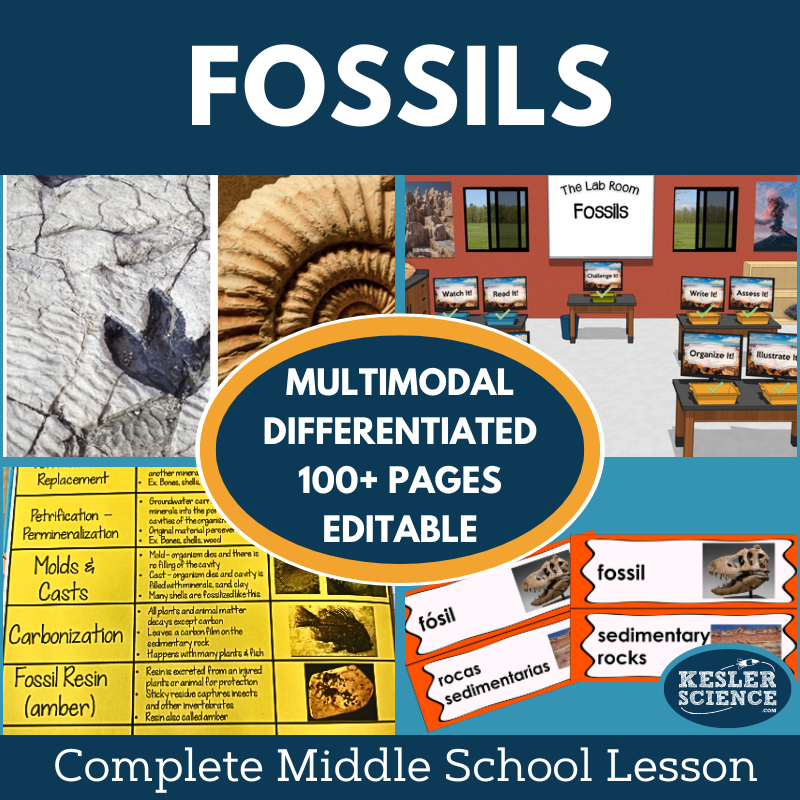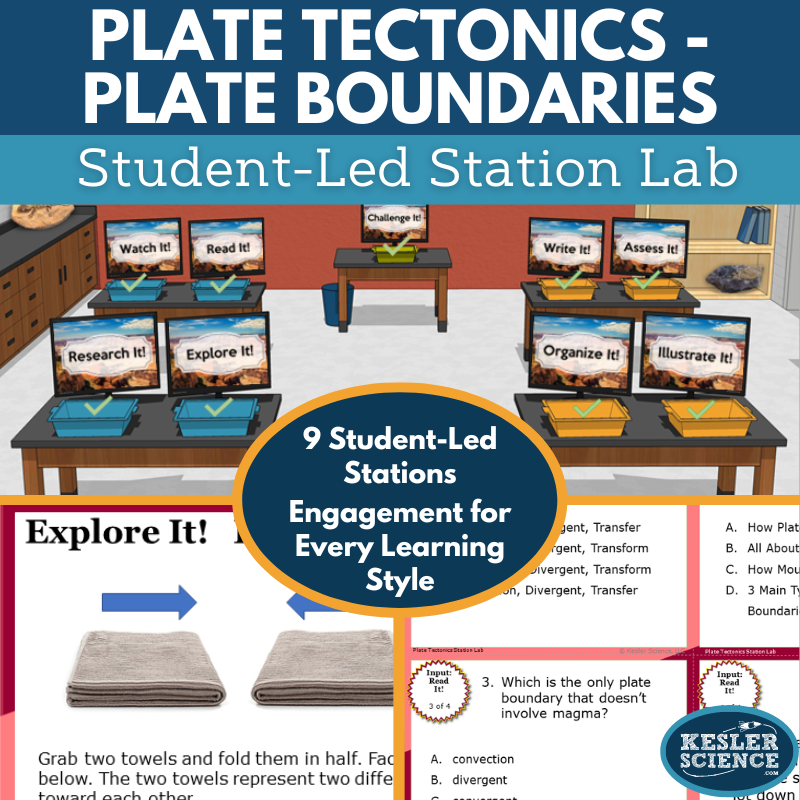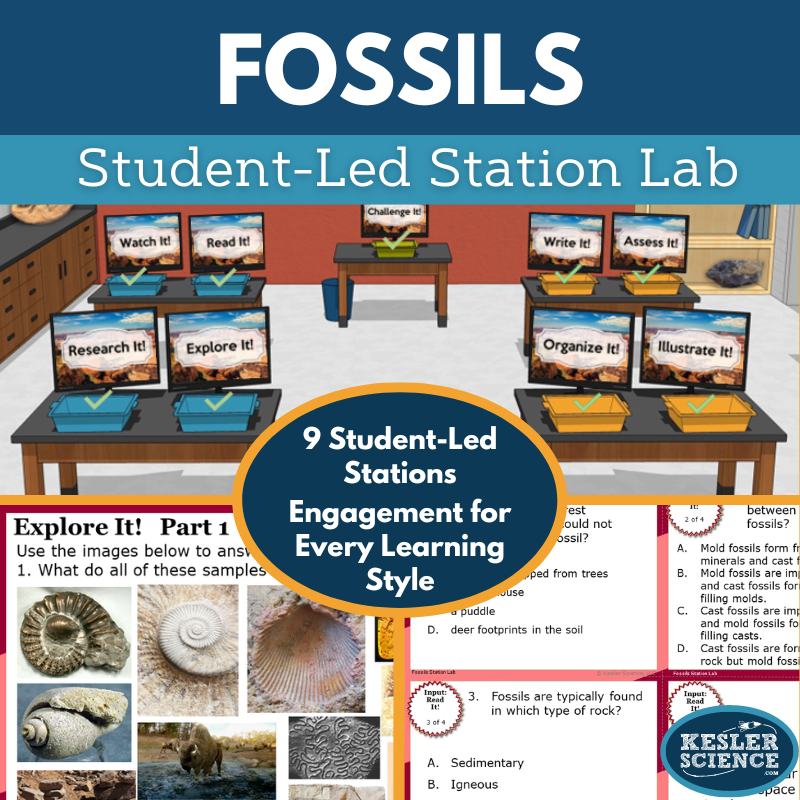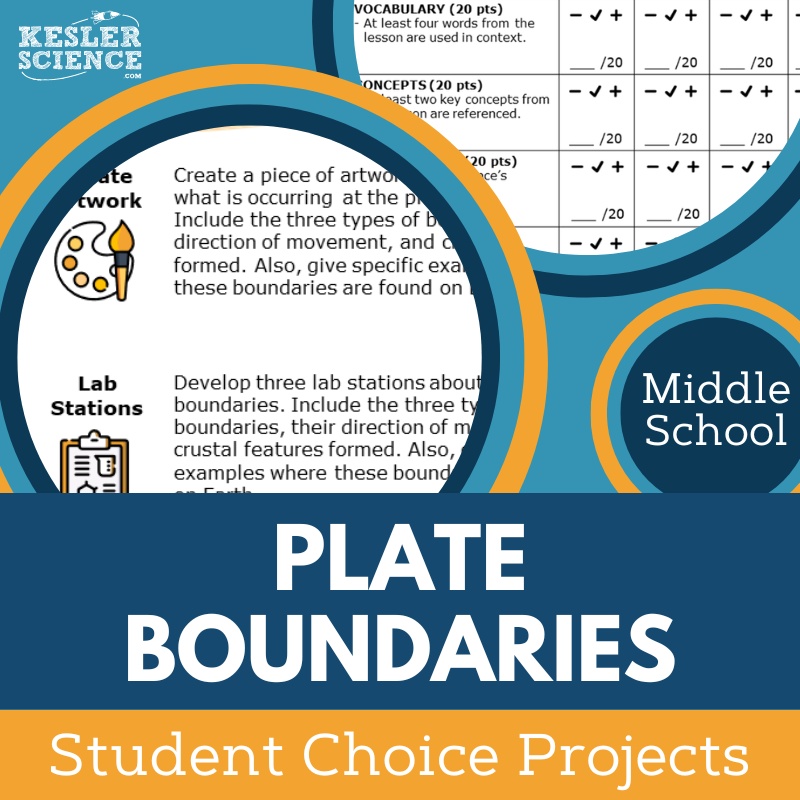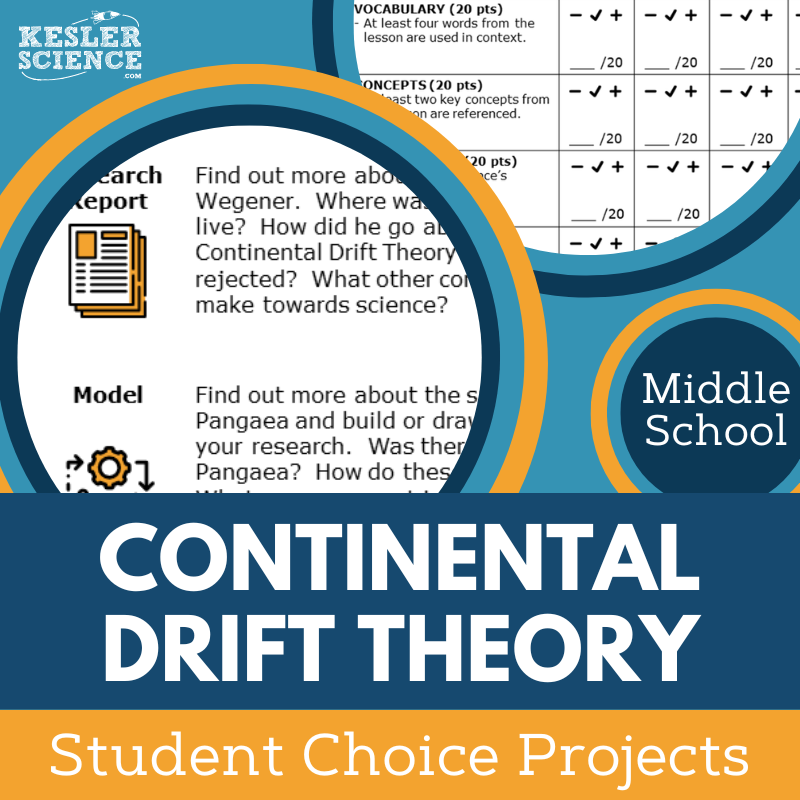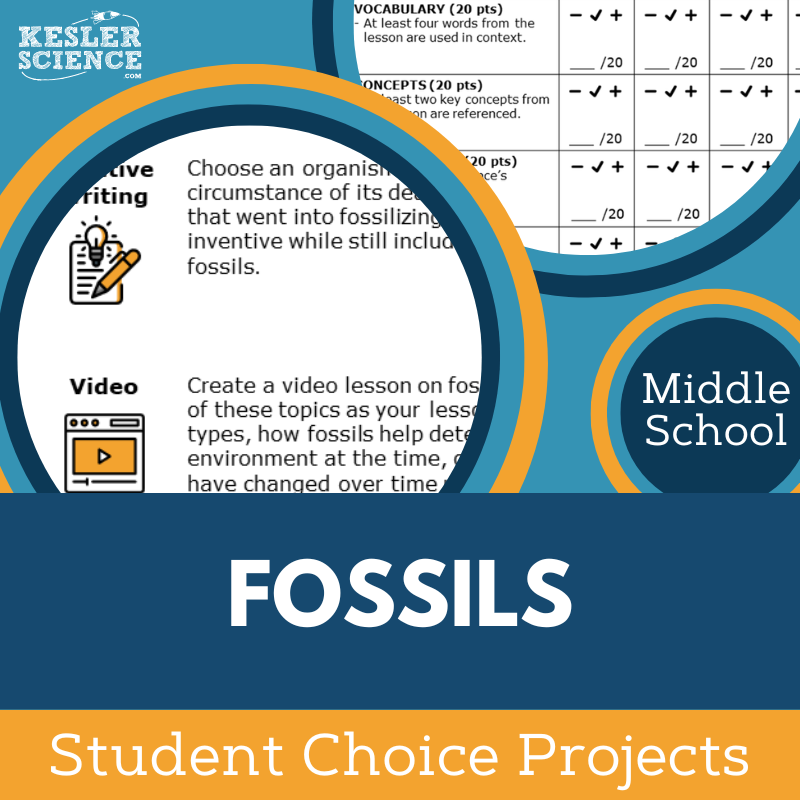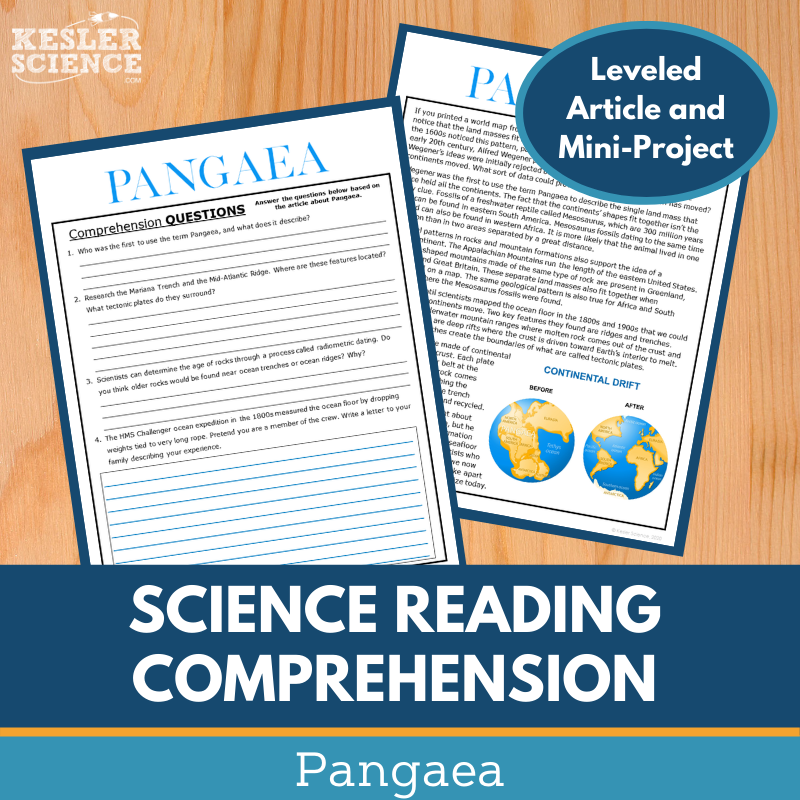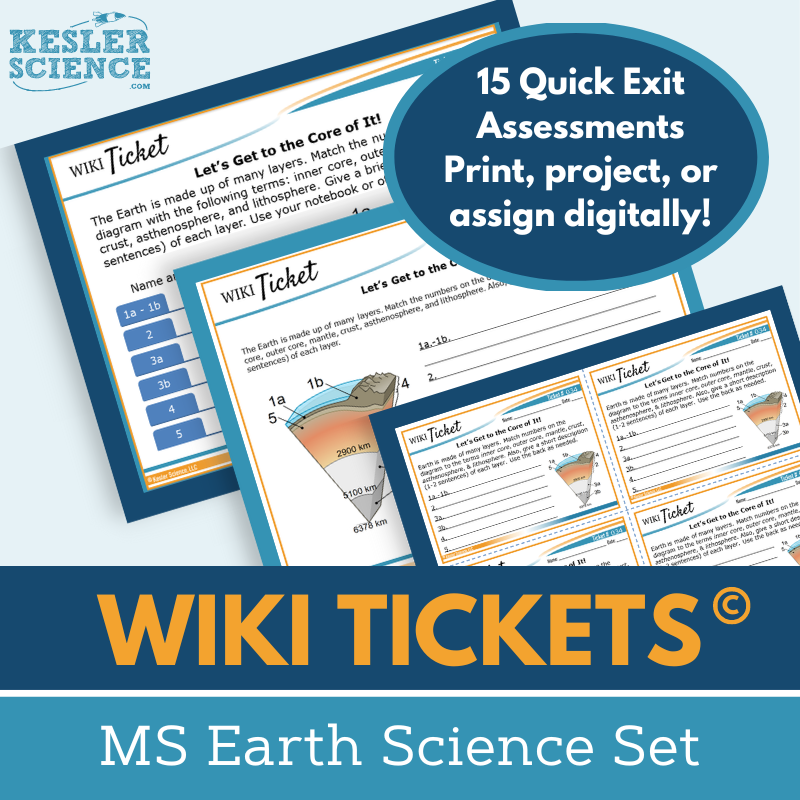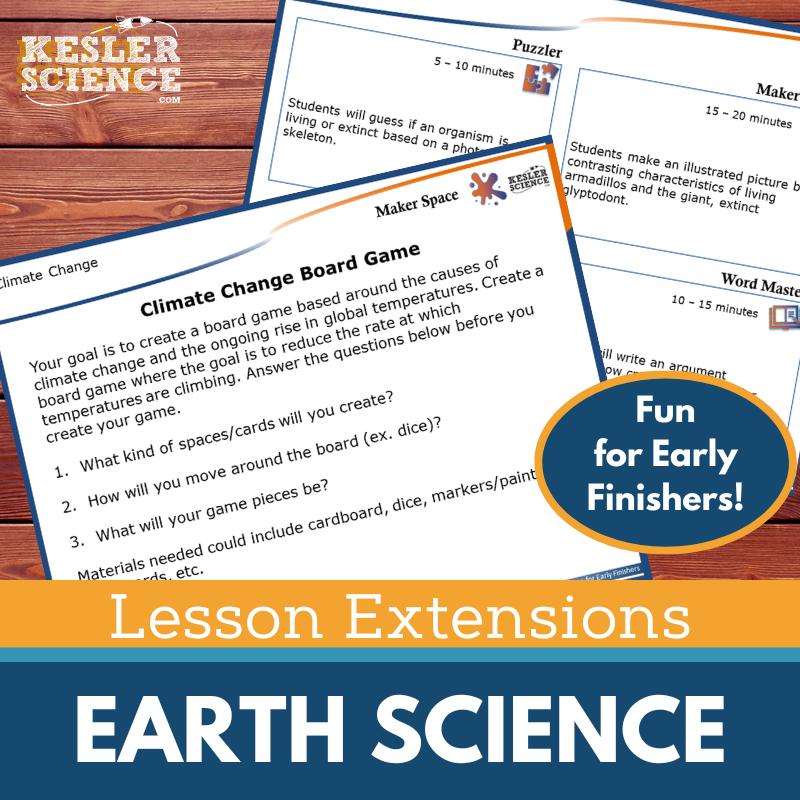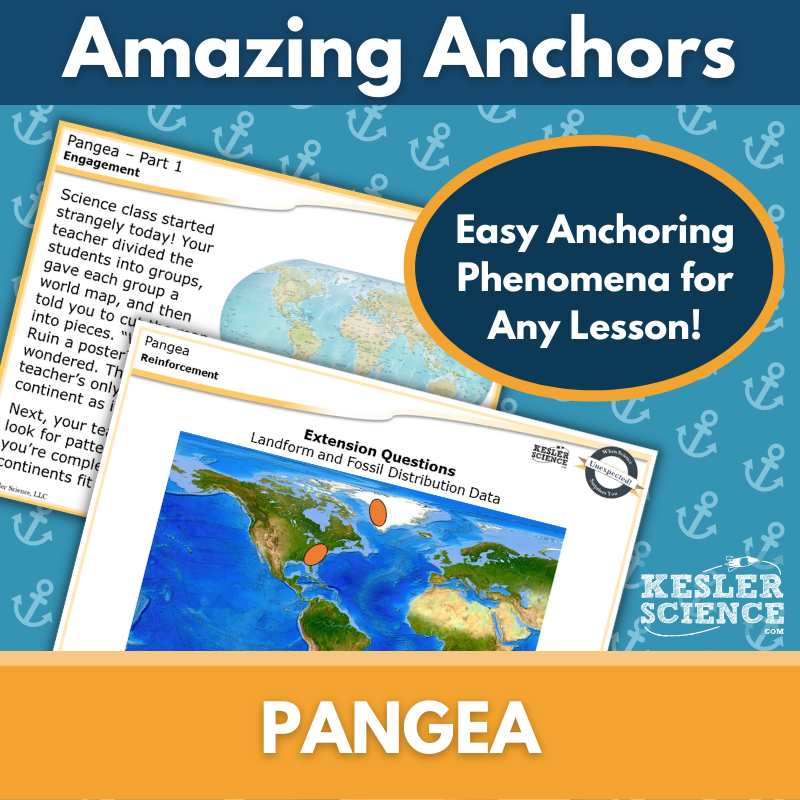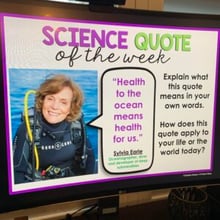Past Plate Motions Activities for Middle School Science
The Kesler Science 5E Lessons on Plate Tectonics, Continental Drift, and Fossils provide comprehensive, student-led learning experiences aligned with NGSS standards. The resources below will give students a comprehensive understanding of past plate motions. All of the following materials are also included in the Kesler Science Membership.
The Kesler Science Plate Tectonics 5E Lesson is a comprehensive, student-led unit designed for middle school. It includes presentations, worksheets, choice projects, and assessments, all fully editable for flexible use. Differentiated and multimodal, the lesson engages students while minimizing teacher prep time.
Aligned with NGSS, this lesson covers key concepts such as plate tectonics, plate boundaries, and crustal features. The unit follows the 5E Model, featuring engagement activities, a hands-on exploration station lab with nine differentiated stations, and interactive PowerPoints and notebooks in English and Spanish. Students extend learning through choice projects and demonstrate understanding with updated STAAR 2.0-aligned assessments.
The resource supports virtual and in-class learning, offering printable and digital formats, Spanish translations, and editable materials.
The Kesler Science Plate Tectonics 5E Lesson is a comprehensive, student-led unit designed for middle school. It includes presentations, worksheets, choice projects, and assessments, all fully editable for flexible use. Differentiated and multimodal, the lesson engages students while minimizing teacher prep time.
Aligned with NGSS, this lesson covers key concepts such as plate tectonics, plate boundaries, and crustal features. The unit follows the 5E Model, featuring engagement activities, a hands-on exploration station lab with nine differentiated stations, and interactive PowerPoints and notebooks in English and Spanish. Students extend learning through choice projects and demonstrate understanding with updated STAAR 2.0-aligned assessments.
The resource supports virtual and in-class learning, offering printable and digital formats, Spanish translations, and editable materials.
The Kesler Science Continental Drift 5E Lesson is a comprehensive middle school unit covering Alfred Wegener’s theory and the evidence supporting continental drift. It includes editable presentations, worksheets, choice projects, and assessments, all designed for differentiated, student-led learning with minimal prep. The lesson aligns with NGSS standards and integrates multimodal learning for engagement.
Following the 5E Model, students begin with vocabulary-building and discussion-based engagement activities. The exploration phase features a differentiated station lab with nine stations, including hands-on experiments, reading passages in English and Spanish, research tasks, videos, and interactive categorization activities. Explanation resources include editable PowerPoints, interactive notebooks, and note-taking templates. Students deepen their understanding through choice projects in the elaboration phase. Evaluation includes updated STAAR 2.0-aligned assessments, review questions, and worksheets.
The lesson is fully flexible, offering digital and printable formats, Spanish translations for key materials, and virtual learning compatibility.
The Kesler Science Continental Drift 5E Lesson is a comprehensive middle school unit covering Alfred Wegener’s theory and the evidence supporting continental drift. It includes editable presentations, worksheets, choice projects, and assessments, all designed for differentiated, student-led learning with minimal prep. The lesson aligns with NGSS standards and integrates multimodal learning for engagement.
Following the 5E Model, students begin with vocabulary-building and discussion-based engagement activities. The exploration phase features a differentiated station lab with nine stations, including hands-on experiments, reading passages in English and Spanish, research tasks, videos, and interactive categorization activities. Explanation resources include editable PowerPoints, interactive notebooks, and note-taking templates. Students deepen their understanding through choice projects in the elaboration phase. Evaluation includes updated STAAR 2.0-aligned assessments, review questions, and worksheets.
The lesson is fully flexible, offering digital and printable formats, Spanish translations for key materials, and virtual learning compatibility.
The Kesler Science Fossils 5E Lesson is a comprehensive unit designed for middle school students, incorporating presentations, worksheets, choice projects, and assessments. This fully editable, multi-day lesson requires minimal prep and supports differentiated, student-led learning. It aligns with NGSS earth science standards and includes Spanish translations of vocabulary, station lab passages, and interactive notebook pages.
Following the 5E Model, the unit begins with engagement activities, including objectives, word wall cards, and class discussions. The exploration phase features a differentiated, student-led station lab with nine stations offering hands-on activities, reading passages, research tasks, videos, and creative output stations. The explanation phase includes editable PowerPoints, interactive notebooks, and note-taking templates. Students extend their learning through choice projects, while evaluation includes STAAR 2.0-aligned assessments and review worksheets.
Designed for maximum flexibility, the lesson is available in digital and printable formats and can be used in virtual or in-person classrooms.
The Kesler Science Fossils 5E Lesson is a comprehensive unit designed for middle school students, incorporating presentations, worksheets, choice projects, and assessments. This fully editable, multi-day lesson requires minimal prep and supports differentiated, student-led learning. It aligns with NGSS earth science standards and includes Spanish translations of vocabulary, station lab passages, and interactive notebook pages.
Following the 5E Model, the unit begins with engagement activities, including objectives, word wall cards, and class discussions. The exploration phase features a differentiated, student-led station lab with nine stations offering hands-on activities, reading passages, research tasks, videos, and creative output stations. The explanation phase includes editable PowerPoints, interactive notebooks, and note-taking templates. Students extend their learning through choice projects, while evaluation includes STAAR 2.0-aligned assessments and review worksheets.
Designed for maximum flexibility, the lesson is available in digital and printable formats and can be used in virtual or in-person classrooms.
Engage your middle school students in a student-led exploration of plate tectonics with this interactive station lab. Designed for independent or small-group learning, the lab helps students identify major tectonic plates through nine differentiated stations featuring videos, readings, research, hands-on activities, and assessments.
Students interact with new concepts through multimodal input stations, including hands-on demonstrations, research tasks, reading passages available in English and Spanish, and video-based learning. Output stations allow them to showcase their understanding through organizing information, sketching models, writing responses, and completing assessments. A challenge station provides extension activities for advanced learners.
This modular, low-prep resource is adaptable for both in-class and virtual learning, offering an engaging and comprehensive approach to earth science education.
Engage your middle school students in a student-led exploration of plate tectonics with this interactive station lab. Designed for independent or small-group learning, the lab helps students identify major tectonic plates through nine differentiated stations featuring videos, readings, research, hands-on activities, and assessments.
Students interact with new concepts through multimodal input stations, including hands-on demonstrations, research tasks, reading passages available in English and Spanish, and video-based learning. Output stations allow them to showcase their understanding through organizing information, sketching models, writing responses, and completing assessments. A challenge station provides extension activities for advanced learners.
This modular, low-prep resource is adaptable for both in-class and virtual learning, offering an engaging and comprehensive approach to earth science education.
Engage your middle school students with this student-led station lab on continental drift theory. Designed for in-class or virtual learning, this activity allows students to explore how continents once fit together into a supercontinent and examine the evidence supporting this theory.
Students direct their own learning through nine interactive stations featuring hands-on demonstrations, research, readings, videos, and creative tasks. They demonstrate understanding by organizing information, illustrating models, writing responses, and completing assessments. A bonus challenge station offers extension activities for advanced learners.
This differentiated, modular resource promotes active engagement and critical thinking while minimizing prep time.
Engage your middle school students with this student-led station lab on continental drift theory. Designed for in-class or virtual learning, this activity allows students to explore how continents once fit together into a supercontinent and examine the evidence supporting this theory.
Students direct their own learning through nine interactive stations featuring hands-on demonstrations, research, readings, videos, and creative tasks. They demonstrate understanding by organizing information, illustrating models, writing responses, and completing assessments. A bonus challenge station offers extension activities for advanced learners.
This differentiated, modular resource promotes active engagement and critical thinking while minimizing prep time.
Engage your middle school students with this modular, student-led Fossils Station Lab aligned with NGSS standards. In this activity, students construct scientific explanations based on evidence from rock strata through nine interactive stations designed for independent or small-group learning. Each station offers differentiated activities, providing personalized learning experiences and supporting early finishers with an additional challenge station.
Input stations include exploring fossils through hands-on demonstrations, researching fossil information online, reading differentiated English and Spanish passages, and watching informative videos. Output stations allow students to demonstrate learning by organizing information with manipulatives, illustrating models, responding to writing prompts, and completing assessments using vocabulary in context. The bonus Challenge station provides engaging extension activities such as crosswords, games, and mini-projects.
This flexible, low-prep resource promotes active learning, critical thinking, and can be used seamlessly for in-person or virtual learning environments.
Engage your middle school students with this modular, student-led Fossils Station Lab aligned with NGSS standards. In this activity, students construct scientific explanations based on evidence from rock strata through nine interactive stations designed for independent or small-group learning. Each station offers differentiated activities, providing personalized learning experiences and supporting early finishers with an additional challenge station.
Input stations include exploring fossils through hands-on demonstrations, researching fossil information online, reading differentiated English and Spanish passages, and watching informative videos. Output stations allow students to demonstrate learning by organizing information with manipulatives, illustrating models, responding to writing prompts, and completing assessments using vocabulary in context. The bonus Challenge station provides engaging extension activities such as crosswords, games, and mini-projects.
This flexible, low-prep resource promotes active learning, critical thinking, and can be used seamlessly for in-person or virtual learning environments.
The Plate Boundaries Student Choice Projects align with NGSS science standards, allowing middle school students to demonstrate their understanding through a project that matches their preferred output style. A project page outlines six student-led options plus a “design your own” project, with an editable rubric for teacher, peer, or self-assessment.
These flexible, multimodal projects offer creative ways for students to showcase their learning. Two versions of the project page support differentiation, with modified options for students needing remediation and challenge opportunities for advanced learners. Teachers can adjust the rubric to fit grading needs.
The projects use standard classroom supplies like paper, markers, and scissors, with many options available for digital completion. Some crafting materials may be useful for building models.
The Plate Boundaries Student Choice Projects align with NGSS science standards, allowing middle school students to demonstrate their understanding through a project that matches their preferred output style. A project page outlines six student-led options plus a “design your own” project, with an editable rubric for teacher, peer, or self-assessment.
These flexible, multimodal projects offer creative ways for students to showcase their learning. Two versions of the project page support differentiation, with modified options for students needing remediation and challenge opportunities for advanced learners. Teachers can adjust the rubric to fit grading needs.
The projects use standard classroom supplies like paper, markers, and scissors, with many options available for digital completion. Some crafting materials may be useful for building models.
The Continental Drift Theory Student Choice Projects align with NGSS science standards, allowing middle school students to select a project that suits their preferred output style. A project page outlines six student-led options plus a “design your own” project, all with an editable rubric for teacher, peer, or self-assessment.
These flexible, multimodal projects provide creative ways for students to demonstrate their understanding. Teachers can adjust the rubric to fit grading needs, and two versions of the project page support differentiation. The modified version includes three project options designed for students needing remediation, while advanced learners can be challenged with multiple projects using the same rubric.
The projects use standard classroom supplies such as paper, markers, and scissors, with many options available for digital completion. Some crafting materials may be useful for model-building.
The Continental Drift Theory Student Choice Projects align with NGSS science standards, allowing middle school students to select a project that suits their preferred output style. A project page outlines six student-led options plus a “design your own” project, all with an editable rubric for teacher, peer, or self-assessment.
These flexible, multimodal projects provide creative ways for students to demonstrate their understanding. Teachers can adjust the rubric to fit grading needs, and two versions of the project page support differentiation. The modified version includes three project options designed for students needing remediation, while advanced learners can be challenged with multiple projects using the same rubric.
The projects use standard classroom supplies such as paper, markers, and scissors, with many options available for digital completion. Some crafting materials may be useful for model-building.
This Fossils Student Choice Projects lesson aligns with NGSS standards, allowing middle school students to select a project based on their preferred style. The included project page offers nine student-led options and a "design your own" choice, supported by an editable rubric suitable for teacher, peer, or self-assessment.
The projects are flexible and multimodal, providing engaging, personalized ways for students to demonstrate their understanding. Differentiation is supported through two versions of the project page: a modified option to assist students needing remediation, and combined projects to challenge advanced learners, all using the same rubric.
Standard classroom materials such as paper, markers, and scissors are sufficient for these projects, and digital completion options are also available. Some projects may benefit from additional crafting supplies for model building.
This Fossils Student Choice Projects lesson aligns with NGSS standards, allowing middle school students to select a project based on their preferred style. The included project page offers nine student-led options and a "design your own" choice, supported by an editable rubric suitable for teacher, peer, or self-assessment.
The projects are flexible and multimodal, providing engaging, personalized ways for students to demonstrate their understanding. Differentiation is supported through two versions of the project page: a modified option to assist students needing remediation, and combined projects to challenge advanced learners, all using the same rubric.
Standard classroom materials such as paper, markers, and scissors are sufficient for these projects, and digital completion options are also available. Some projects may benefit from additional crafting supplies for model building.
The Fossil Distribution Inquiry Lab aligns with NGSS MS-ESS2-3, helping students analyze fossil evidence to understand plate tectonics. This lab is available in both digital and print formats, offering interactive virtual activities or hands-on experiments.
Students explore how fossil distribution supports the theory of plate movement through differentiated lab versions tailored to different learning levels. The dependent version guides students with structured inquiry, the modified version offers additional support with simplified questions, and the independent version encourages student-led exploration.
The print format includes a hands-on lab where students use maps, scissors, crayons, glue, paper, and clay to simulate continental drift. The digital version is an interactive PowerPoint compatible with Google Slides, requiring no physical materials. Both formats incorporate comprehension questions, Claim-Evidence-Reasoning (C.E.R.) prompts, and reflection activities.
Editable PowerPoints, teacher resource pages, and answer keys provide flexibility and ease of use, ensuring an engaging and adaptable learning experience.
The Fossil Distribution Inquiry Lab aligns with NGSS MS-ESS2-3, helping students analyze fossil evidence to understand plate tectonics. This lab is available in both digital and print formats, offering interactive virtual activities or hands-on experiments.
Students explore how fossil distribution supports the theory of plate movement through differentiated lab versions tailored to different learning levels. The dependent version guides students with structured inquiry, the modified version offers additional support with simplified questions, and the independent version encourages student-led exploration.
The print format includes a hands-on lab where students use maps, scissors, crayons, glue, paper, and clay to simulate continental drift. The digital version is an interactive PowerPoint compatible with Google Slides, requiring no physical materials. Both formats incorporate comprehension questions, Claim-Evidence-Reasoning (C.E.R.) prompts, and reflection activities.
Editable PowerPoints, teacher resource pages, and answer keys provide flexibility and ease of use, ensuring an engaging and adaptable learning experience.
The Plate Tectonics Escape Room is an interactive activity that allows students to explore plate tectonics and Wegener's continental drift theory in an engaging way. Designed to align with NGSS standards MS-ESS2-2 and MS-ESS2-3, this escape room challenges students to construct explanations based on geoscience evidence and analyze data related to fossils, rock distribution, and seafloor structures.
Teachers have full control over the eight independent puzzles, choosing which to use and in what order, making the activity adaptable for different class lengths. The escape room can be conducted using simple materials like manila envelopes or a more immersive setup with locks, a lockout hasp, and a storage box. A digital version is available via PowerPoint or Google Slides, allowing students to interact with questions and images online. A printable version can also be assigned for at-home learning.
This resource includes teacher directions, a detailed answer key, digital and printable student versions, a digital answer sheet via Google Forms, a video challenge, and eight unique puzzles with all necessary printable props. Also included are reward templates, over 50 prize ideas, and 30 unique signs for a fun photo finish.
The Plate Tectonics Escape Room is an interactive activity that allows students to explore plate tectonics and Wegener's continental drift theory in an engaging way. Designed to align with NGSS standards MS-ESS2-2 and MS-ESS2-3, this escape room challenges students to construct explanations based on geoscience evidence and analyze data related to fossils, rock distribution, and seafloor structures.
Teachers have full control over the eight independent puzzles, choosing which to use and in what order, making the activity adaptable for different class lengths. The escape room can be conducted using simple materials like manila envelopes or a more immersive setup with locks, a lockout hasp, and a storage box. A digital version is available via PowerPoint or Google Slides, allowing students to interact with questions and images online. A printable version can also be assigned for at-home learning.
This resource includes teacher directions, a detailed answer key, digital and printable student versions, a digital answer sheet via Google Forms, a video challenge, and eight unique puzzles with all necessary printable props. Also included are reward templates, over 50 prize ideas, and 30 unique signs for a fun photo finish.
This Pangaea Science Reading Comprehension Lesson helps students explore Earth's systems by analyzing fossil distribution as evidence of past plate motions. Designed for middle school, the leveled passage supports science literacy and reading comprehension.
The resource includes two Lexile-leveled nonfiction articles (1100-1300), five to seven comprehension questions, a hands-on mini-project, and a Cornell notes template. It features engaging graphics that print well in grayscale.
Perfect for sub plans, ISS, extra credit, or whole-class instruction, this resource fosters critical thinking, classroom discussions, and textual analysis. It is compatible with virtual learning platforms like Google Classroom, MS Teams, Schoology, and Canvas.
This Pangaea Science Reading Comprehension Lesson helps students explore Earth's systems by analyzing fossil distribution as evidence of past plate motions. Designed for middle school, the leveled passage supports science literacy and reading comprehension.
The resource includes two Lexile-leveled nonfiction articles (1100-1300), five to seven comprehension questions, a hands-on mini-project, and a Cornell notes template. It features engaging graphics that print well in grayscale.
Perfect for sub plans, ISS, extra credit, or whole-class instruction, this resource fosters critical thinking, classroom discussions, and textual analysis. It is compatible with virtual learning platforms like Google Classroom, MS Teams, Schoology, and Canvas.
The Tectonic Plate Movement Science Writing Prompt Activity engages middle school students in creative journal writing exercises to enhance their understanding of earth science and plate tectonics. Aligned with NGSS MS-ESS2-3, students analyze and interpret data related to fossils, rocks, continental shapes, and seafloor structures to provide evidence of past tectonic movements. This low-prep, student-centered resource supports both in-person and virtual learning.
The activity includes teacher directions with answer guides, project ideas, rubrics, projection options, and printable handouts in full and half-sheet formats suitable for interactive notebooks or journals. Additionally, a digital interactive PowerPoint version compatible with Google Slides is provided. This resource can serve as a cross-curricular activity, formative assessment, student choice project, enrichment for early finishers, differentiation, TELPAS samples, extra credit, or make-up work. Completed prompts can also be displayed creatively on bulletin boards or compiled into student anthologies.
The Tectonic Plate Movement Science Writing Prompt Activity engages middle school students in creative journal writing exercises to enhance their understanding of earth science and plate tectonics. Aligned with NGSS MS-ESS2-3, students analyze and interpret data related to fossils, rocks, continental shapes, and seafloor structures to provide evidence of past tectonic movements. This low-prep, student-centered resource supports both in-person and virtual learning.
The activity includes teacher directions with answer guides, project ideas, rubrics, projection options, and printable handouts in full and half-sheet formats suitable for interactive notebooks or journals. Additionally, a digital interactive PowerPoint version compatible with Google Slides is provided. This resource can serve as a cross-curricular activity, formative assessment, student choice project, enrichment for early finishers, differentiation, TELPAS samples, extra credit, or make-up work. Completed prompts can also be displayed creatively on bulletin boards or compiled into student anthologies.
The WIKI Tickets© Earth Science Set provides engaging, flexible formative assessments for 6th-8th grade science. This set includes 15 topics, each available in five formats: a full-screen projection version, three printable handout options, and an interactive digital version compatible with PowerPoint and Google Slides.
Aligned with NGSS and TEKS standards, these assessments cover key earth science topics, including ecoregions in Texas, human impact on the environment and natural resources, land and erosion features, Earth's layers, tectonic plates, minerals, the rock cycle, and watersheds. Each standard has at least one corresponding ticket, with some topics having multiple assessments. A bonus table of contents file provides alignment details.
Designed for both in-person and virtual learning, WIKI Tickets© can be used as exit tickets, bellringers, or quick comprehension checks. Students can respond on printed handouts, their own paper, or digitally in a 1:1 or remote setting. These colorful assessments help you gauge student understanding with ease.
The WIKI Tickets© Earth Science Set provides engaging, flexible formative assessments for 6th-8th grade science. This set includes 15 topics, each available in five formats: a full-screen projection version, three printable handout options, and an interactive digital version compatible with PowerPoint and Google Slides.
Aligned with NGSS and TEKS standards, these assessments cover key earth science topics, including ecoregions in Texas, human impact on the environment and natural resources, land and erosion features, Earth's layers, tectonic plates, minerals, the rock cycle, and watersheds. Each standard has at least one corresponding ticket, with some topics having multiple assessments. A bonus table of contents file provides alignment details.
Designed for both in-person and virtual learning, WIKI Tickets© can be used as exit tickets, bellringers, or quick comprehension checks. Students can respond on printed handouts, their own paper, or digitally in a 1:1 or remote setting. These colorful assessments help you gauge student understanding with ease.
Lesson Extensions provide engaging, student-choice activities that challenge early finishers while reinforcing critical thinking and creativity. Designed to enhance earth science lessons, these activities align with NGSS and TEKS standards, offering a meaningful way to scaffold learning, fill downtime, and maintain student engagement.
Each Lesson Extension includes four interactive components: Puzzler for problem-solving, Maker Space for hands-on STEAM activities, Tech Connection for digital demonstrations, and Word Master for creative writing. With teacher directions, answer keys, and both print and projection versions, these extensions support independent learning and lesson wrap-ups.
Covering topics such as climate change, plate tectonics, the fossil record, mineral properties, and geological time scales, Lesson Extensions provide rigorous yet enjoyable challenges that encourage deeper exploration of earth science concepts.
Lesson Extensions provide engaging, student-choice activities that challenge early finishers while reinforcing critical thinking and creativity. Designed to enhance earth science lessons, these activities align with NGSS and TEKS standards, offering a meaningful way to scaffold learning, fill downtime, and maintain student engagement.
Each Lesson Extension includes four interactive components: Puzzler for problem-solving, Maker Space for hands-on STEAM activities, Tech Connection for digital demonstrations, and Word Master for creative writing. With teacher directions, answer keys, and both print and projection versions, these extensions support independent learning and lesson wrap-ups.
Covering topics such as climate change, plate tectonics, the fossil record, mineral properties, and geological time scales, Lesson Extensions provide rigorous yet enjoyable challenges that encourage deeper exploration of earth science concepts.
This Amazing Anchors Phenomenon Lesson easily integrates tectonic plate movement into your middle school science curriculum through a captivating, real-world phenomenon. It begins with an introductory reading about the puzzle of Pangea, including comprehension and extension questions to prepare students for deeper learning. A follow-up explanatory reading clearly breaks down the science behind tectonic plate movement and includes additional reinforcement questions.
Aligned with NGSS standard MS ESS2-3, this no-prep resource provides teacher directions, answer keys, projection slides, and both digital and print formats suitable for Google Classroom and other LMS platforms. It also includes differentiated versions with sentence starters to support diverse learners. Ideal for the Engagement and Elaborate stages of a 5E lesson, this resource effectively introduces and reinforces key scientific concepts.
This Amazing Anchors Phenomenon Lesson easily integrates tectonic plate movement into your middle school science curriculum through a captivating, real-world phenomenon. It begins with an introductory reading about the puzzle of Pangea, including comprehension and extension questions to prepare students for deeper learning. A follow-up explanatory reading clearly breaks down the science behind tectonic plate movement and includes additional reinforcement questions.
Aligned with NGSS standard MS ESS2-3, this no-prep resource provides teacher directions, answer keys, projection slides, and both digital and print formats suitable for Google Classroom and other LMS platforms. It also includes differentiated versions with sentence starters to support diverse learners. Ideal for the Engagement and Elaborate stages of a 5E lesson, this resource effectively introduces and reinforces key scientific concepts.
Year-Round Resources
These year-round activities will increase your students' understanding of many middle school science topics. All of these activities are also included in the Kesler Science Membership.
Visual Data & Graphing
You're not alone if your students struggle with understanding graphs, charts, and tables. It's a skill that takes an enormous amount of practice. This resource will help students build a strong foundation in analyzing data and creating their own data visualizations.
Bell Ringers and Warm-Ups
These middle school science bell ringers are an excellent way to engage your students as soon as they walk into your classroom. This comprehensive FULL YEAR resource includes everything you need to start off each science class with an interesting warm-up activity.
Review Board Games
Each game board has been carefully designed to keep students engaged. There are 10 different action spaces on each board and dozens of question cards. All of the actions are related to science concepts and keep the students motivated throughout the game.
Each game is ready to play. Simply print out the board and the cards and let the students enjoy reviewing nine different units.
Essential Questions and Standards
Below are the essential questions and standards associated with the lessons and activities included in the past plate motions unit. This topic is only one of more than 100 middle school science topics included in the Kesler Science Membership.
-
What is plate tectonics?
-
What are the three types of plate boundaries?
-
What crustal features are formed at plate boundaries?
-
Who was Alfred Wegener?
-
What is the historical evidence that supports the Continental Drift Theory?
-
What causes the movement of the continents?
-
What are fossils?
-
What are some different types of fossilization?
-
What is the difference between relative and absolute age?
-
What does the fossil record tell scientists?
-
What organisms today have similarities to organisms of the past?
-
NGSS - MS-ESS2-3 Past Plate Motions
Kesler Science Membership
Imagine never having to search for another middle school science lesson again. The membership gives you access to ALL of the Kesler Science products in one place (Yes, including everything above).
Say goodbye to long hours of lesson prep.



